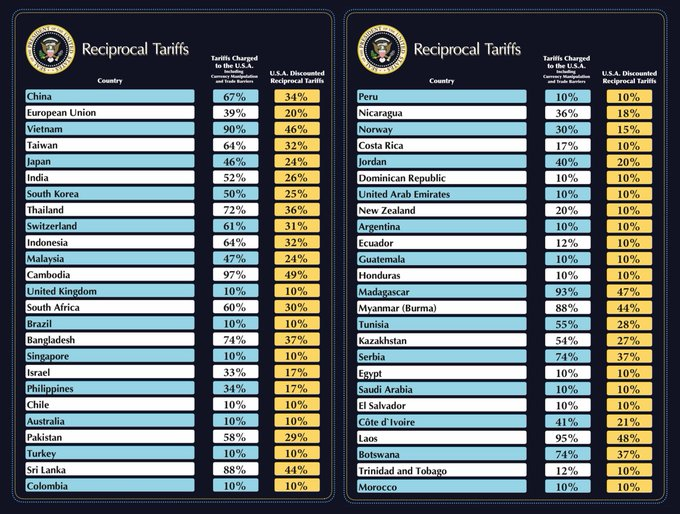Calculate the cost of Trump's tariffs on Malaysia as trade tensions mount, industries strain, and regional stability faces its toughest test yet!
{{ vm.tagsGroup }}
15 Apr 2025
6 Min Read
Afrina Arfa (Alumni Columnist), Nellie Chan (Editor)
Calculate the cost of Trump's tariffs on Malaysia as trade tensions mount, industries strain, and regional stability faces its toughest test yet!

'My fellow Americans, this is Liberation Day.'
With those words, President Donald Trump addressed the American public—and the watching world—on 2nd April 2025 from the White House Rose Garden, delivering a speech that sent shockwaves across the globe. Defying the advice of policymakers, economists, and even close advisors, Trump announced a 'reciprocal tariff' policy aimed at reshaping the global economic order—beginning with a universal 10% tariff on all imports, set to take effect just three days later, on 5th April.
The move stunned governments, markets, and trade partners. But the shock was short-lived. On 10th April, Trump took to social media to declare a 90-day pause on the newly imposed tariff for most countries, expressing confidence that 'fair deals for everybody' could be made. China, however, was excluded—its imports were hit with a staggering 145% tariff. Still, the damage had been done: economists scrambled to assess the fallout, governments rushed to respond and revise their trade strategies, and countries around the world braced for impact—including Malaysia.
Tariffs—taxes imposed on imported goods—have long been central to Trump's economic strategy. He argues that they would reduce the US's dependence on foreign products, stimulate domestic manufacturing, and generate revenue for reinvestment at home. Framed as a defensive measure, the policy was pitched as a response to what Trump described as decades of exploitation by foreign 'cheaters' and a nation 'pillaged' by unfair trade.
While the policy appeared data-driven on the surface, its implementation told a different story. The tariff rate for each country was calculated using a simplified formula: the US trade balance with that country (exports minus imports), divided by the total value of US imports from that country. The resulting figure was then halved—framed as a 'discounted' tariff rate—with a minimum floor of 10%. However, the formula relied solely on trade data from 2024—a year still skewed by post-pandemic distortions and uneven global recovery.
Trump's focus on correcting trade deficits underpinned the policy's design, but it failed to address the deeper structural forces driving those imbalances. Chief among them is the US dollar's status as the world's reserve currency, which increases global demand for dollars, making American exports more expensive and imports cheaper—widening the trade deficit. Compounding the issue is the long-standing practice of US firms outsourcing production to countries with lower labour costs, further tilting the trade balance.
If the real goal was to reduce trade deficits, economists argue that the formula should have accounted for broader macroeconomic factors—such as savings and investment dynamics, currency strength, and global trade patterns. Instead, the tariff structure appeared to function more as a political tool, notably in light of the abrupt 90-day grace period, which seemed designed to gain negotiating leverage or project geopolitical strength.
When the world's largest economy imposes tariffs at this scale, the consequences inevitably cascade far beyond its borders. Retaliatory measures, disrupted supply chains, and shaken investor confidence threaten to slow growth in trade-reliant countries—Malaysia among them. If the tariffs return after the three-month window closes, the question remains: Can Malaysia's economy withstand the blow?
Photo credits: @WhiteHouse on X
While neighbouring countries like Vietnam and Indonesia were hit with steep tariff rates—46% and 32%, respectively—Malaysia, though not the hardest hit, still faced a substantial 24% tariff. This rate was calculated based on Malaysia's trade surplus with the US, which totalled RM72.4 billion in 2024. Given the scale of bilateral trade—the US is Malaysia's third-largest trading partner—the impact of the tariffs is not merely statistical; it directly affects some of Malaysia's most globally integrated industries.
The semiconductor industry, in particular, illustrates this vulnerability. As the world's sixth-largest semiconductor exporter, Malaysia plays a pivotal role in global supply chains—especially in assembly, packaging, and testing. Many of the firms operating within the industry are US-based multinationals that rely on Malaysia as a key manufacturing hub. A significant share of their output is re-exported to the US, meaning the tariffs disrupt not only Malaysian exports but also the operations of these firms. This disruption weakens Malaysia's position in the global semiconductor market and creates knock-on effects across other major export industries, including electronics, machinery, and, to a lesser extent, rubber.
Beyond semiconductors, higher tariffs inflate the cost of Malaysian goods in the US market, making them less competitive and dampening demand from American consumers. As export volumes decline, Malaysia's overall trade performance deteriorates—triggering ripple effects across the broader economy. This tariff-induced pressure—reflected in rising costs and disrupted supply chains—can deter foreign investment, suppress domestic consumption, and lead to job losses in export-reliant industries. With tightening margins, firms may delay or scale back investment, further stalling economic growth.
In response to the tariff shock, Malaysia—serving as chair of the Association of Southeast Asian Nations (ASEAN) for the year—convened a special meeting to coordinate the region's next steps. Recognising the diversity of economic structures and vulnerabilities across Southeast Asia, ASEAN economic ministers ultimately opted against retaliation despite member states facing tariff rates ranging from 10% to as high as 49%. Just hours after the bloc issued a joint statement calling for 'a frank and constructive dialogue with the US' to address trade-related concerns, Trump unexpectedly announced a three-month pause on the tariffs.
Still, preparing for the potential fallout—during or after the pause—remains critical. ASEAN members now face the difficult task of balancing internal competition with regional cooperation. Malaysia's comparatively lower 24% tariff rate may position it to attract investment redirected from higher-tariff neighbours. However, this potential advantage also brings growing pressure on Malaysia to support a unified ASEAN response—one that could strengthen the bloc's collective bargaining position with the US.
Yet, achieving that unity is easier said than done. Unlike the European Union (EU), ASEAN is not a formal trade bloc with a centralised authority. Instead, it operates under a hybrid framework—allowing coordination on shared issues while leaving trade policy to the discretion of individual member states. This structural limitation makes it difficult to deliver a cohesive response to external shocks like the US tariffs, leaving countries like Malaysia to manage the fallout largely on their own.
Malaysia has begun taking steps to mitigate the impact of the US tariffs while laying the groundwork for longer-term economic resilience. A delegation led by Investment, Trade and Industry Minister Tengku Zafrul is scheduled to travel to Washington by the end of April to negotiate improved trade terms. Beyond short-term diplomacy, however, the broader challenge is structural.
Malaysia's reliance on low- to mid-value manufacturing leaves it vulnerable to external shocks. Transitioning into higher-value sectors—such as medical devices, biotechnology, and advanced electronics, as outlined in the New Industrial Master Plan 2030 (NIMP 2030)—could help the country move up the value chain and reduce its overdependence on US demand.
Expanding regional trade is another critical strategy. Increasing intra-ASEAN trade and strengthening ties with other global economic blocs would open new markets and reduce Malaysia's exposure to any single trading partner while reinforcing its position in regional supply networks.
Domestically, monetary policy has a role to play in maintaining stability. Keeping the Overnight Policy Rate (OPR) steady for at least the next 12 months would help manage inflation risks linked to rising import costs, limiting domestic volatility amid global trade uncertainty.
Though the tariffs are temporarily on hold, their effects are already reverberating through Malaysia's trade-dependent economy. In the face of growing uncertainty, complacency is not an option. The coming months will test Malaysia's ability to adapt—through smart diplomacy, strategic diversification, and stronger regional integration. If it rises to the challenge, Malaysia can not only cushion the blow but reposition itself as a more resilient and competitive player in the evolving global economy.
Afrina Arfa is a Bachelor of Finance and Economics (Honours) alumna of Taylor's University. She spends her time indulging in economic news, hoping to inspire others to think beyond the constraints of society.
